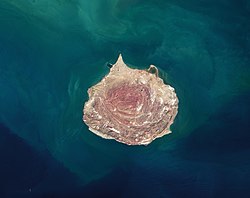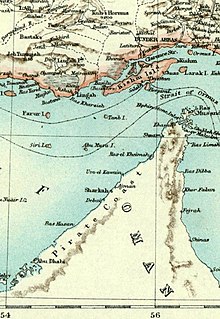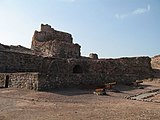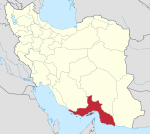geo.wikisort.org - Island
Hormuz Island (/hɔːrˈmuːz/; Persian: جزیره هرمز Jazireh-ye Hormoz), also spelled Hormoz, is an Iranian island in the Persian Gulf. Located in the Strait of Hormuz, 8 km (5 mi) off the Iranian coast, the island is part of Hormozgan Province. It is sparsely inhabited, but some development has taken place since the late 20th century.
This article includes a list of references, related reading or external links, but its sources remain unclear because it lacks inline citations. (February 2022) |
Hormuz Island | |
|---|---|
 Satellite photo of Hormuz Island | |
 | |
 | |
| Coordinates: 27°04′03″N 56°27′36″E | |
| Country | |
| Province | Hormozgān |
| Area | |
| • Land | 42 km2 (16.2 sq mi) |
| Elevation | 186 m (610 ft) |
| Time zone | UTC+3:30 (IRST) |


History
The earliest evidence for human presence on the island is several stone artifacts discovered at the eastern shorelines of the Island. A lithic scatter was found at a site called Chand-Derakht, which is an uplifted marine Pleistocene terrace. This site yielded a Middle Paleolithic lithic assemblage characterized by Levallois methods and dates back to more than 40,000 years ago.[1]
The island, known as Organa (Όργανα) to the ancient Greeks and as Jarun in the Islamic period, acquired the name of "Hormuz" from the important harbour town of Hormuz (Ormus) on the mainland 60 km away, which had been a centre of a minor principality on both sides of the strait. The principality paid tribute to the Mongol-ruled Ilkhanate and was an important source of income from maritime trade.[2] The town's ruler decided to shift his residence to the island around 1300, in order to evade attacks by Mongolian and Turkish groups from the interior.[3] The ruler later made peace with the Ilkhans.
A new town was built on the northern tip of Jarun island which was called New Hormuz for a number of years to distinguish it from the old town on the mainland until this fell into ruins. Slowly the name of the new town came to be used for the island as well.
The island is arid, and during the summer months, the temperature can rise to over 43 °C (109 °F). As such, it was not an ideal location for the capital of a principality as all provisions including water had to be brought from the mainland. Its location, however, gave the island a degree of security which let it grow to be a major trading port for several centuries. As its competitors suffered from intermittent destruction, Hormuz remained a reliable and relatively safe harborage.
Hormuz was visited by Marco Polo, around 1290, while traveling by land, as described in his travelogue.
Ibn Battuta also visited the island and New Hormuz.[4]

In 1505 King Manuel I of Portugal led Portugal to establish a policy of expansion in Africa and western Asia. During attempts to expand Portuguese influence into the Indian Ocean, the Portuguese duke Afonso de Albuquerque captured the island in 1507 and it was incorporated into the greater Portuguese Empire. The Portuguese constructed a fortress on the island to deter potential invaders, naming it the Fort of Our Lady of the Conception. The island became an emergency stopover point for Portuguese ships traveling to Goa, Gujarat and nearby Kishm. The Ottomans laid siege to the island under the admiral and cartographer Piri Reis in 1552.[5] In 1622 the island was captured from the Portuguese by a combined Anglo-Persian force at the behest of the English East India Company.
Shah Abbas I distrusted the local population and was not interested in maintaining the island as a trading centre or military post; instead he developed the nearby mainland port of Bandar Abbas. Hormuz went into decline. Many of its inhabitants seasonally moved to their fields and orchards around the old Hormuz on the mainland, only fishermen being in permanent residence. The island continued to export small quantities of rock salt and lumps of iron oxide which were used as ballast stones for sailing ships.[6]
After a period of Omani administration in the 19th century, it remained a sparsely inhabited fishermen's island before experiencing some development in the later years of the 20th century.
Geography and geology
Hormuz Island has an area of 42 km2 (16 sq mi). It is covered by sedimentary rock and layers of volcanic material on its surface. The highest point of the island is about 186 m (610 ft) above sea level. Due to a lack of precipitation, the soil and water are salty. Specialists have helped cultivar white mangrove or Hara trees to grow in the climate. Due to the lack of fresh water, Iranian engineers have constructed a water pipeline from the mainland. There are many beaches that go all around the island.[citation needed]
Reddish ochre on the island and its beaches, called Golak by natives, has been exploited for artistic and culinary purposes, and also attracts tourists. Degradation due to overuse of the ochre has resulted in actions by the Department of Environment to protect it.[7]
The rocks show that, over thousands of years that the island of Hormuz gradually rose out of the water, eroded into different shapes. The geological age of the Hormuz island is about 600 million years, and its life out of the water is about 50 thousand years.[8]
Attractions
Statues Valley
With a few hundred meters walk to the beach, in a way that silver sands attracts attention, rocks can be seen in many different forms, each is likened to an animal, a sheep's head, poultry and many different Dragons.[citation needed]
Red Beach
Hormuz Island has a ground soil rich in red ferrious oxide soil, called “Gelack”, which is not just a valuable mineral for industrial purposes, but the locals use it as a spice in their cuisine, such as sauces, jams, etc.
The mountain being on the shoreline, makes the peculiarly red beach and red waves of the sea an unmissable sight to see. What is more, walking along the shore, you will encounter parts where sand glitters with metal compounds.[9]
Mangrove forest
Hormuz island is a collection of wonderful mangrove trees with its beautiful waterways and wild birds with its pristine nature is a big source of tourist, and every year a lot of people come to Hormuz island to watch these beautiful sights. Mangrove plants are created in the Eocene and Oligocene, Sea Forest is one of the most surprising elements of creation in the world. Trees that live in the saltwater tidal area. Even more strange is that sometimes , most of them sink under the salty sea water but still continue to exist. Iran’s southern coast is known for its arid and salty sea water. But the amazing thing is this grassy area, that grows without the need for fresh sweet water. In a story this mythical plant is grown from Adam’s tears.[10]
Dr. Nadalian Museum

The Museum of Dr Nadalian in Hormuz Island, also known as the Museum and Gallery of Ahmad Nadalian in Hormuz Island, shows the work of Ahmad Nadalian (born 1963[11]), whose works have been shown in galleries internationally.[12] His environmental art projects include rock carvings, and not only his work, but also that of local indigenous women, bones of sea creatures are displayed in his museum,[13] and dolls made of recycled materials.[14]
The museum was created in March 2009 as the Paradise Art Centre, being renamed in 2012 to its current name. Also at this time, its entrance was redesigned with inspiration from local architecture.[15]
Gallery
- Hormuz Island beach
- Hormoz Island
- The Fort of Our Lady of the Conception, Hormuz Island
- Hara forests at Hormuz Island
- The sea cliffs near the Valley of Statues of Hormuz Island
- Art made from ochre on the islands beaches
References
- Zarei, Sepehr, (2021) The First Evidence of the Pleistocene Occupation in the Hormuz Island: A Preliminary Report, Bulletin of Miho Museum 21:101-110.
- Cambridge history of India, vol. 1, p.147
- H. Yule, The Book of Ser Marco Polo, 1903, vol. I, p. 110, quoting Abulfeda ("Hormuz was devastated by the incursions of the Tartars, and its people transferred their abode to an island in the sea called Zarun, near the continent, lying west of the old city.") and Odoric for the date.
- Battutah, Ibn (2002). The Travels of Ibn Battutah. London: Picador. pp. 98–99, 308. ISBN 9780330418799.
- Pîrî Reis’in Hürmüz Seferi ve İdamı Hakkındaki Türk ve Portekiz Tarihçilerinin Düşünceleri Archived 2012-12-02 at the Wayback Machine Ertuğrul Önalp. Prof. Dr. Ankara Üniversitesi, Dil ve Tarih-Coğrafya Fakültesi, İspanyol Dili ve Edebiyatı Anabilim Dalı. (in Turkish)
- "HORMUZ ii. ISLAMIC PERIOD – Encyclopaedia Iranica". www.iranicaonline.org. Archived from the original on May 20, 2020. Retrieved Mar 31, 2020.
- Hormuz, the rainbow island of Iran Archived 2020-03-28 at the Wayback Machine. Tehran Times (2017-10-14). Retrieved 2020-03-28.
- "دره مجسمه ها Statues Valley". هتل جزیره هرمز &#; Hotel in Hormuz island. Archived from the original on August 12, 2020. Retrieved Mar 31, 2020.
- [/ "Hormuz island red beach"]. هتل جزیره هرمز &#; Hotel in Hormuz island. Archived from the original on August 12, 2020. Retrieved Mar 31, 2020.
{{cite web}}: Check|url=value (help) - "جنگل حرا mongrove forest". هتل جزیره هرمز &#; Hotel in Hormuz island. Archived from the original on August 10, 2022. Retrieved Mar 31, 2022.
- "About". Dr. Nadalian. 31 August 2021. Archived from the original on 14 February 2022. Retrieved 14 February 2022.
- "The Museum and Gallery of Dr. Ahamd Nadalian in Hormuz Island". Dr. Nadalian. 30 September 2021. Archived from the original on 14 February 2022. Retrieved 14 February 2022.
- "The Museum of Dr. Ahmad Nadalian in Hormuz". alaedin.travel (in Latin). Archived from the original on 14 February 2022. Retrieved 14 February 2022.
- Rasaneh, Sirang (12 June 1906). "Dr. Ahmad Nadalian Museum & Gallery 2022 Tourist Attraction in Hormoz Island". Iran Tourism & Touring. Archived from the original on 14 February 2022. Retrieved 14 February 2022.
- "WWW.RiverArt.Net- Environmental Works by A. Nadalian هنر رودخانه: آثار دكتر احمد نادعليان". www.riverart.net. Archived from the original on March 1, 2020. Retrieved Mar 31, 2020.
Sources
- .الكوخردى ، محمد ، بن يوسف، (كُوخِرد حَاضِرَة اِسلامِيةَ عَلي ضِفافِ نَهر مِهران) الطبعة الثالثة ،دبى: سنة 199۷ للميلاد Mohammed Kookherdi (1997) Kookherd, an Islamic civil at Mehran river, third edition: Dubai
- . کامله،القاسمی، بنت شیخ عبدالله، (تاریخ لنجة) مکتبة دبي للتوزیع، الامارات: الطبعة الثانية عام ۱۹۹۳ للمیلاد
- . الوحیدی الخنجی، حسین بن علی بن احمد، «تاریخ لنجه» ، الطبعة الثانية دبی: دار الأمة للنشر والتوزیع، ۱۹۸۸ للمیلاد
- . اطلس گیتاشناسی استانهای ایران Gitashenasi Province Atlas of Iran Atlas Gitashenasi Ostanhai Iran [dead link]
- . دره مجسمه ها Statue Valley Hormuz Island Archived 2019-08-13 at the Wayback Machine
Further reading
- Speak the Wind (Mack, 2021; photographs by Hoda Afshar; essay by Michael Taussig[1]) This work documents the landscapes and people of the islands of Hormuz Island, Qeshm, and Hengam, in the Persian Gulf off the south coast of Iran.[2][3] Afshar got to know some of the people there, travelling there frequently over the years, and they told her about the history of the place. She said that "their narrations led the project", and she explores "the idea of being possessed by history, and in this context, the history of slavery and cruelty”.[4]
External links
- Hormuz, The Bloody Island of Iran The Globetrotting Detective.
- Afshar, Hoda; Taussig, Michael (2021). Speak the Wind. Photographs by Hoda Afhsar; essay by Michael Taussig. London: Mack. ISBN 978-1-913620-18-9.
- Boetker-Smith, Daniel; Afshar, Hoda. "Speak the Wind - Book review". LensCulture. Photographs by Hoda Afshar. Archived from the original on 14 February 2022. Retrieved 14 February 2022.
- Colberg, Jörg (16 August 2021). "Speak The Wind". Conscientious Photography Magazine. Archived from the original on 14 February 2022. Retrieved 14 February 2022.
- Grieve, Michael (19 July 2021). "Hoda Afshar captures the wind and rituals of the islands in the Strait of Hormuz". 1854 Photography. Archived from the original on 14 February 2022. Retrieved 14 February 2022.
На других языках
[de] Hormus (Insel)
Hormus oder Hormuz (persisch هرمز Hormoz, älter auch Ormuz) ist eine zu Iran gehörige kahle Felseninsel im Persischen Golf und liegt 18 Kilometer östlich der Insel Qeschm in der Straße von Hormus.- [en] Hormuz Island
[es] Ormuz (isla)
Ormuz (en persa: Hormoz) es una isla iraní en el golfo Pérsico. Se encuentra en la mitad del estrecho de Ormuz, a 18 km al este de la isla Qeshm y cerca de 16 km al sudeste de Bandar Abbas. Forma parte de la provincia de Hormozgān.[fr] Île d'Ormuz
Ormuz est une île iranienne située dans le détroit d'Ormuz. Elle dispose d'une importance stratégique par sa position au débouché du golfe Persique.[it] Hormuz
Hormuz o Hormoz, anticamente Ormus[1], in farsi هرمز, è un'isola del Golfo Persico che fa parte del territorio iraniano di Hormozgan. Amministrativamente è una delle 3 circoscrizioni dello shahrestān di Qeshm, con la città di Hormoz.[ru] Ормуз (остров)
Орму́з (перс. جزیره هرمز) — остров в Ормузском проливе, входит в состав остана Хормозган Исламской Республики Иран.Другой контент может иметь иную лицензию. Перед использованием материалов сайта WikiSort.org внимательно изучите правила лицензирования конкретных элементов наполнения сайта.
WikiSort.org - проект по пересортировке и дополнению контента Википедии






